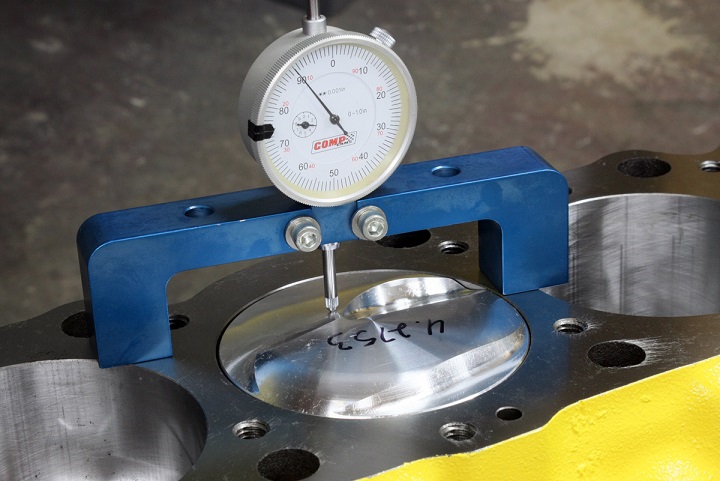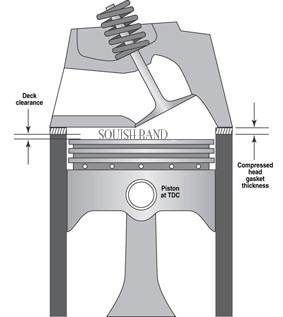you might want to read through this thread also.
a couple KEY factors in getting any smaller displacement SBC engine to perform well, is your going to have to get the static compression ratio up in the 10.5:1 or higher range and match the cam duration and lift to maximize the port air flow rates in the upper rpm range, and that will generally require selecting a solid lifter cam, use of tuned headers with a low restriction exhaust, and gearing the cars drive train to allow it to maximize, the engines ability to breath in the 4500 rpm-7500 rpm, range that a short stroke 3"-3.25" SBC engine is capable of if properly designed and constructed
the cylinder head port size required can be easily calculated,many guys seem to think your limited to a certain size port for a certain displacement, but the fact is that theres far more factors that effect the correct port configuration and port size than engine displacement alone.
the bore size of the smaller SBC engines like a 265 or 283 won,t physically allow the use of the larger 2.02" intake and 1.60" exhaust valves, especially with longer duration high lift cam profiles.
if you do the research youll find that carefully matched cam timing,and header design can be used to increase the cylinder fill efficiency.


always accurately measure the crank main journals, and remember the crank and block bearing sizes on a 400 sbc and 350 smc are different as are the early 283-327 sbc

USE THE CALCULATORS to match port size to intended rpm levels... but keep in mind valve lift and port flow limitations
http://www.wallaceracing.com/runnertorquecalc.php
http://www.wallaceracing.com/ca-calc.php
http://www.wallaceracing.com/area-under-curve.php
http://www.wallaceracing.com/chokepoint.php
http://www.wallaceracing.com/header_length.php
http://www.circletrack.com/enginetech/1 ... ch_engine/
While cheat sheets might have frowned upon in your sixth-grade classroom, we strongly encourage them in the garage, shop, or pits. That’s why we’ve put together this list of 13 key performance formulas you should know when building or tuning your street or race vehicle.
http://garage.grumpysperformance.co...lap-on-factory-headers.3155/page-2#post-66722
http://www.race-cars.net/calculators/compression_calculator.html
http://garage.grumpysperformance.com/index.php?threads/a-few-calculator-links.7108/#post-27382
http://www.projectpontiac.com/ppsite15/compression-ratio-calculator
http://www.wallaceracing.com/dynamic-cr.php
http://www.rbracing-rsr.com/comprAdvHD.htm
http://performancetrends.com/Compression_Ratio_Calculator_V2.3.htm
http://www.wallaceracing.com/cr_test2.php
http://www.pcengines.com.au/calculators/Calculate dynamic Comp Ratio.htm
http://www.csgnetwork.com/compcalc.html
http://www.diamondracing.net/tools/
https://www.uempistons.com/index.php?main_page=calculators&type=comp
https://www.rbracing-rsr.com/compstaticcalc.html
Racing Carburetor CFM
Racing Carburetor CFM = RPM x Displacement ÷ 3456 x 1.1
Note: Summit Racing also offers this CFM Calculator to make the job easier.
Displacement
Displacement = .7854 x Bore2 x Stroke x Number of Cylinders
Correct Compression Ratio (CCR)
CCR = FCR (Altitude/1,000) x .2
Note: You can also take this Compression Ratio Calculator tool for a spin.
Tire Diameter
Tire Diameter = (MPH x Gear Ratio x 336) ÷ RPM
Rocker Arm Ratio and Valve Lift
Gross Valve Lift = Camshaft Lobe Lift x Rocker Arm Ratio
Horsepower
Horsepower = (RPM x Torque) ÷ 5,252
Torque
Torque = (5,252 x HP) ÷ RPM
Rod Ratio
Rod Ratio = Rod Length ÷ Crank Stroke Length
Average Piston Speed
Average Piston Speed = Crank Stroke x RPM ÷ 6
Rear Gear Ratio
Rear Gear Ratio = (RPM at Finish Line x Tire Diameter) ÷ (MPH x 336)
Note: You can also save this link to a handy Gear Ratio calculator.
Volume (CCs) of Deck Clearance
CCs of Deck Clearance = Bore x Bore x 12.87 x Depth of Deck Clearance
Volume (CCs) of Head Gasket
CCs of Head Gasket = Bore x Bore x 12.87 x Thickness of Head Gasket
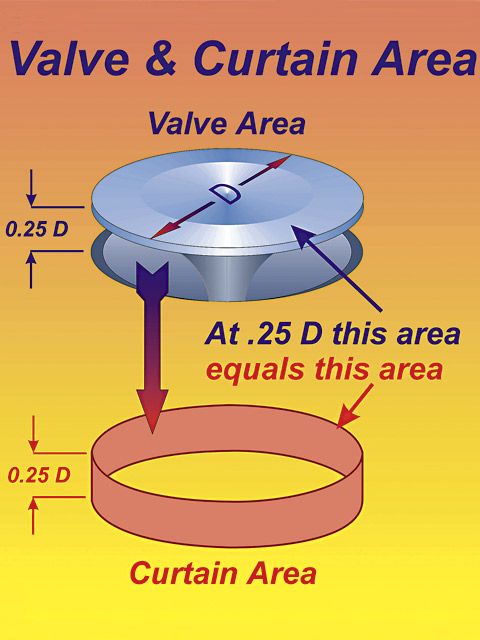
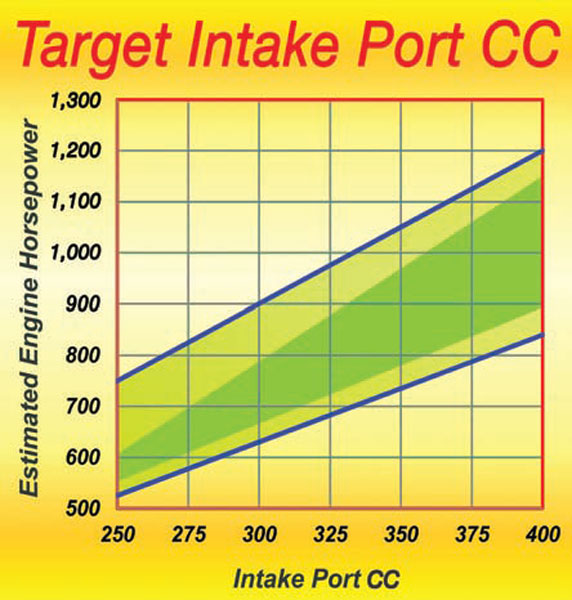
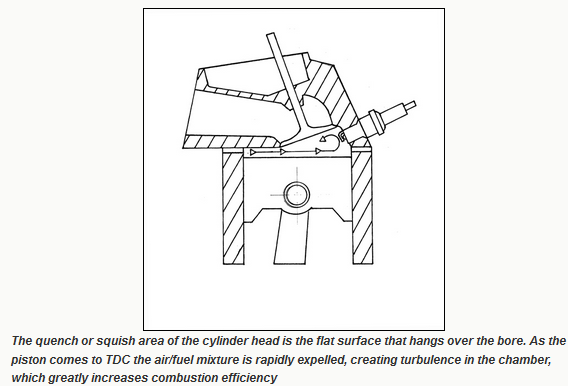
Intake Port to Torque Peak
here's a chart FROM THE BOOK,HOW TO BUILD BIG-INCH CHEVY SMALL BLOCKS with some common cross sectional port sizes
(measured at the smallest part of the ports)
...........................sq inches........port cc
edelbrock performer rpm ....1.43.............170
vortec......................1.66.............170
tfs195......................1.93.............195
afr 180.....................1.93.............180
afr 195.....................1.98.............195
afr 210.....................2.05.............210
dart pro 200................2.06.............200
dart pro 215................2.14.............215
brodix track 1 .............2.30.............221
dart pro 1 230..............2.40.............230
edelbrock 23 high port .....2.53.............238
edelbrock 18 deg............2.71.............266
tfs 18 deg..................2.80.............250
COMMON SBC INTAKE PORTS
felpro # 1204=Port Size: 1.23" x 1.99"=2.448 sq inches
felpro # 1205=Port Size: 1.28" x 2.09"=2.67 sq inches
felpro # 1206=Port Size: 1.34" x 2.21"=2.96 sq inches
felpro # 1207=Port Size: 1.38" x 2.28"=3.146 sq inches
felpro # 1209=Port Size: 1.38" x 2.38"=3.28 sq inches
felpro # 1255 VORTEC=Port Size: 1.08" x 2.16"-2.33 sq inches
felpro # 1263=Port Size: 1.31" x 2.02"=2.65 sq inches
felpro # 1266=Port Size: 1.34" x 2.21"=2.96 sq inches
felpro # 1284 LT1=Port Size: 1.25 x 2.04''=2.55 sq inches
felpro # 1289 FASTBURN=Port Size: 1.30" x 2.31" 3.00 sq inches
http://garage.grumpysperformance.co...ut-building-a-283-305-or-307-this-may-be.427/
If your looking to build a rather serious 283 sbc in a light weight car
, yes you can get good power,the potential strong suite of the 283 sbc is it potential to rpm in the 5000 rpm-to-8000 rpm range with its short 3" stroke with the proper matching valve train and compression
but it won,t be very useful below about 4500rpm,
and hardly ideal for daily street driving or useful on pump octane fuel
the heads you select will be rather critical here so don,t scrimp, youll need decent roller rockers AND a matching rocker stud girdle,

http://www.summitracing.com/parts/tfs-30400700/overview/
the 175cc port and 56cc combustion chamber sbc trick flow cylinder heads that are about $590 EACH or about $1200 for a pair fit the application well
and yes some time spent , by a reasonably skilled porting specialist or your machine shop or you, in port and bowl area clean-up port work and plenum clean up, port matching, on the intake manifold, and use of open headers, will be nearly mandatory
http://www.grumpysperformance.com/tfsairflows.pdf

http://www.summitracing.com/parts/tfs-30310002
YES THE tfs-30310002 with the 1.47 better valve springs
YES YOULL NEED to swap the valve retainers and install even better and stronger valve springs, but of the correct load rate for the cam and lifters, that handle a .600 lift with additional clearance,
this engines going to be shifting at about 8k rpm
with a 3" stroke you have the potential to build a decent high rpm engine so you may as well take advantage of the engines true potential.
http://www.summitracing.com/parts/crn-11759-16
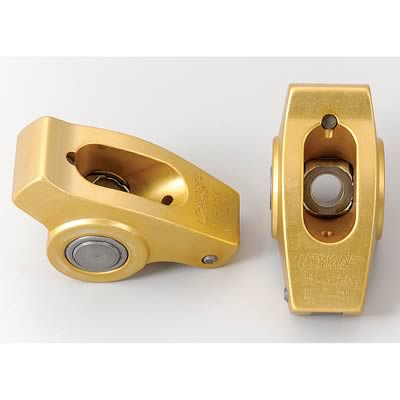
http://www.summitracing.com/parts/crn-110921
crane solid lifter cam
http://www.summitracing.com/parts/cro-66909x980-16
crower cool face solids
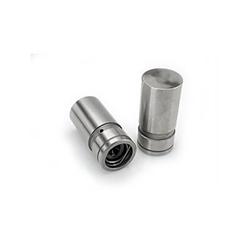
intake manifold
http://www.summitracing.com/parts/edl-7501/overview/make/chevrolet
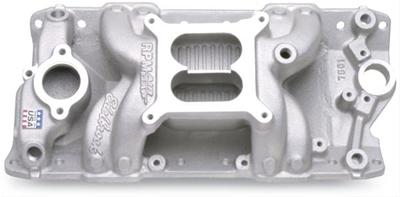
For a Chevrolet 350, the traditional rod journal size is 2.1 inches. Engine builders have found there are numerous advantages of a smaller journal size, the most significant being that it slows the bearing speed. there are spacer rod bearings to use the 2.1" connecting rods on the 283 & 327 sbc smaller 2.0 rod journal diam.
http://www.lunatipower.com/Product.aspx?id=309
rods
http://www.jegs.com/i/Scat/942/26000716/10002/-1?parentProductId=761557

If I was building it ID want 1 5/8" long tube open headers, youll want J&E forged pistons that produce 11:1 compression
low drag rings, Id suggest a .120 valve to piston clearance on both valves.
a heat barrier piston deck coating, a .044 quench
youll want a 7-8 quart baffled oil pan with a windage tray
you'll
want a 750 cfm holley carburetor.
a manual transmission, in the lightest car available, like a T-BUCKET,
with at least a 28"-29" tire and a 4.88:1 rear gear, and your launching at about 4500 rpm off the line, internal balance and a 30 lb steel billet flywheel and sfi flywheel and clutch and blow proof bell housing, and a 200 hp wet nitrous plate system
N/A (hell yes you need race gas octane)

with race octane gas and WET 200HP nitrous plate
http://www.summitracing.com/parts/zex-82040
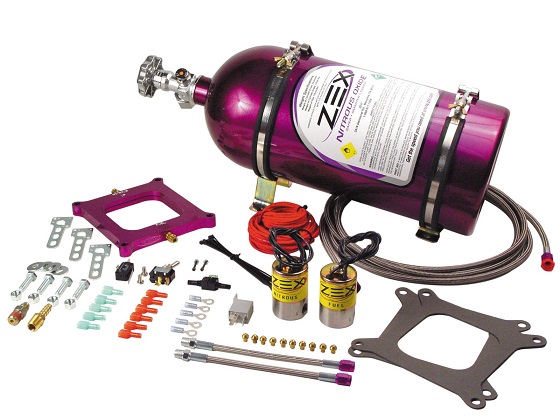
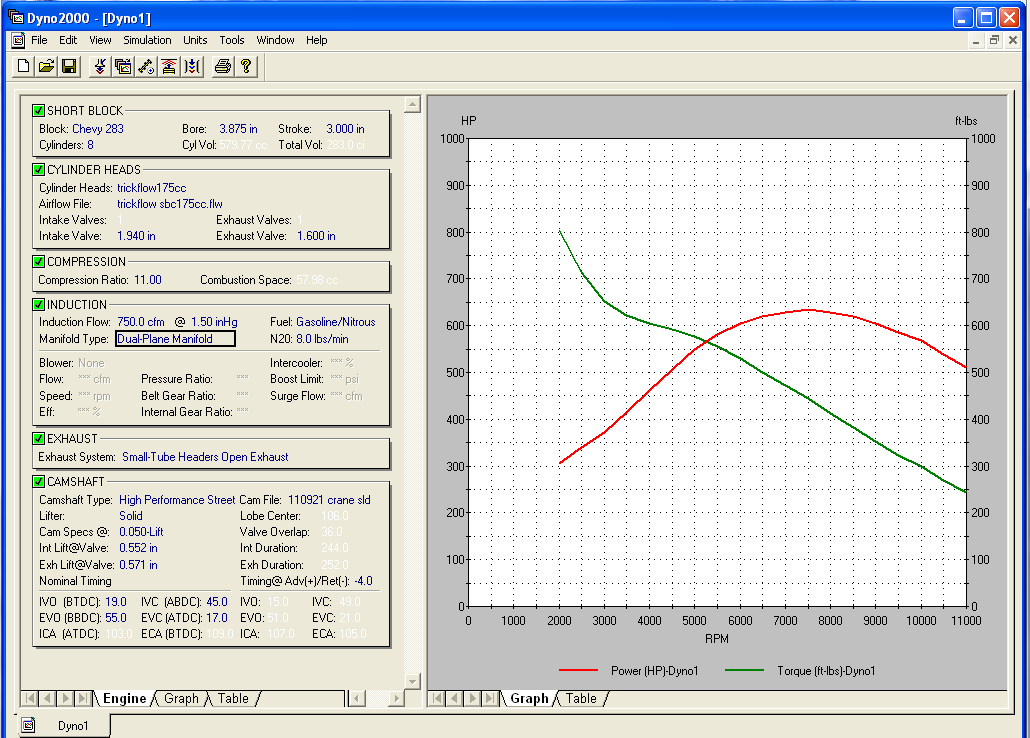
a 302 can be built to provide an impressive power curve but it will need to operate in the 4500 rpm-7500 rpm power band to maximize its power potential
back in the 1970s a great many of us , looking for better power in a 302 or the high performance and high compression versions of the 327 ,swapped the valve springs out for much better valve springs, installed rocker stud girdles, extra tall valve covers, on mildly ported fuelie heads or if you were bucks up you bought CRANE fireball PORTED heads , (usually Casting Number 3890462) CANDFIELD OR or brownfield aluminum heads and installed long tube headers, and low restriction exhaust systems in Z28"s, and VEGAS with 4 speed transmissions and used 11:1 compression 302-327 and a few 377 engines and we used a 780 cfm holley or dual 500 cfm carter carb dual quads, we installed a 4.11:1 -4.56:1 rear gear's we used the bigest slicks that would fit the cars, and used a crane 110921 solid lifter cam and 1.6:1 roller rockers (that was a very well respected combo) (a few of us used SMOKEY RAM INTAKES) and we had very noticeable improvements in the cars performance.
keep in mind that youll want a 7-8 quart capacity , baffled oil pan with a windage tray thats been carefully installed with the correct clearances anda balanced rotating assembly with ideally 6" connecting rods and forged components for the crank rods and pistons and use of ARP 7/16" rod bolts, and a manual transmission, SFI certified billet flywheel and a blow proof bell housing, too maintain consistent oil pressure, and keep your toes attached to your feet, and increase durability as stock O.E.M. components will not last forever if your spinning the engine north of 7500 rpm consistently
if you could tune and set up a suspension, had decent traction bars ,etc. , had decent slicks and you had the skills too drive well, ten second 1/4 mile time slips were occasionally seen, even back them , in a vega or lightened camaro or nova.
of course with the better cylinder heads now available like the 215CC large port vorted or 210cc AFR or 215cc BRODIX adding an aditional 60 hp-100hp to those older engines would be rather easy.
http://garage.grumpysperformance.com/index.php?threads/long-rod-302.12866/
http://garage.grumpysperformance.com/index.php?threads/smokeram-or-str10.3431/#post-9088
http://www.superchevy.com/how-to/project-cars/sucp-1004-high-rpm-302-engine-build/
http://www.superchevy.com/how-to/project-cars/sucp-0903-302-small-block-engine-build/
http://www.superchevy.com/how-to/project-cars/sucp-0903-302-small-block-engine-build/
a couple KEY factors in getting any smaller displacement SBC engine to perform well, is your going to have to get the static compression ratio up in the 10.5:1 or higher range and match the cam duration and lift to maximize the port air flow rates in the upper rpm range, and that will generally require selecting a solid lifter cam, use of tuned headers with a low restriction exhaust, and gearing the cars drive train to allow it to maximize, the engines ability to breath in the 4500 rpm-7500 rpm, range that a short stroke 3"-3.25" SBC engine is capable of if properly designed and constructed
the cylinder head port size required can be easily calculated,many guys seem to think your limited to a certain size port for a certain displacement, but the fact is that theres far more factors that effect the correct port configuration and port size than engine displacement alone.
the bore size of the smaller SBC engines like a 265 or 283 won,t physically allow the use of the larger 2.02" intake and 1.60" exhaust valves, especially with longer duration high lift cam profiles.
if you do the research youll find that carefully matched cam timing,and header design can be used to increase the cylinder fill efficiency.


always accurately measure the crank main journals, and remember the crank and block bearing sizes on a 400 sbc and 350 smc are different as are the early 283-327 sbc

USE THE CALCULATORS to match port size to intended rpm levels... but keep in mind valve lift and port flow limitations
http://www.wallaceracing.com/runnertorquecalc.php
http://www.wallaceracing.com/ca-calc.php
http://www.wallaceracing.com/area-under-curve.php
http://www.wallaceracing.com/chokepoint.php
http://www.wallaceracing.com/header_length.php
http://www.circletrack.com/enginetech/1 ... ch_engine/
While cheat sheets might have frowned upon in your sixth-grade classroom, we strongly encourage them in the garage, shop, or pits. That’s why we’ve put together this list of 13 key performance formulas you should know when building or tuning your street or race vehicle.
http://garage.grumpysperformance.co...lap-on-factory-headers.3155/page-2#post-66722
http://www.race-cars.net/calculators/compression_calculator.html
http://garage.grumpysperformance.com/index.php?threads/a-few-calculator-links.7108/#post-27382
http://www.projectpontiac.com/ppsite15/compression-ratio-calculator
http://www.wallaceracing.com/dynamic-cr.php
http://www.rbracing-rsr.com/comprAdvHD.htm
http://performancetrends.com/Compression_Ratio_Calculator_V2.3.htm
http://www.wallaceracing.com/cr_test2.php
http://www.pcengines.com.au/calculators/Calculate dynamic Comp Ratio.htm
http://www.csgnetwork.com/compcalc.html
http://www.diamondracing.net/tools/
https://www.uempistons.com/index.php?main_page=calculators&type=comp
https://www.rbracing-rsr.com/compstaticcalc.html
Racing Carburetor CFM
Racing Carburetor CFM = RPM x Displacement ÷ 3456 x 1.1
Note: Summit Racing also offers this CFM Calculator to make the job easier.
Displacement
Displacement = .7854 x Bore2 x Stroke x Number of Cylinders
Correct Compression Ratio (CCR)
CCR = FCR (Altitude/1,000) x .2
Note: You can also take this Compression Ratio Calculator tool for a spin.
Tire Diameter
Tire Diameter = (MPH x Gear Ratio x 336) ÷ RPM
Rocker Arm Ratio and Valve Lift
Gross Valve Lift = Camshaft Lobe Lift x Rocker Arm Ratio
Horsepower
Horsepower = (RPM x Torque) ÷ 5,252
Torque
Torque = (5,252 x HP) ÷ RPM
Rod Ratio
Rod Ratio = Rod Length ÷ Crank Stroke Length
Average Piston Speed
Average Piston Speed = Crank Stroke x RPM ÷ 6
Rear Gear Ratio
Rear Gear Ratio = (RPM at Finish Line x Tire Diameter) ÷ (MPH x 336)
Note: You can also save this link to a handy Gear Ratio calculator.
Volume (CCs) of Deck Clearance
CCs of Deck Clearance = Bore x Bore x 12.87 x Depth of Deck Clearance
Volume (CCs) of Head Gasket
CCs of Head Gasket = Bore x Bore x 12.87 x Thickness of Head Gasket



Intake Port to Torque Peak
- Long Port Length: Improve low RPM range
- Short Port Length: Improve high RPM range
- Large Cross Section: Works better on larger CID and higher RPM
- Too large of a cross section can cause reversion and less power
- Small Cross Section: Works better on smaller CID and lower RPM
- Smallest cross section without losing HP is the best size
here's a chart FROM THE BOOK,HOW TO BUILD BIG-INCH CHEVY SMALL BLOCKS with some common cross sectional port sizes
(measured at the smallest part of the ports)
...........................sq inches........port cc
edelbrock performer rpm ....1.43.............170
vortec......................1.66.............170
tfs195......................1.93.............195
afr 180.....................1.93.............180
afr 195.....................1.98.............195
afr 210.....................2.05.............210
dart pro 200................2.06.............200
dart pro 215................2.14.............215
brodix track 1 .............2.30.............221
dart pro 1 230..............2.40.............230
edelbrock 23 high port .....2.53.............238
edelbrock 18 deg............2.71.............266
tfs 18 deg..................2.80.............250
COMMON SBC INTAKE PORTS
felpro # 1204=Port Size: 1.23" x 1.99"=2.448 sq inches
felpro # 1205=Port Size: 1.28" x 2.09"=2.67 sq inches
felpro # 1206=Port Size: 1.34" x 2.21"=2.96 sq inches
felpro # 1207=Port Size: 1.38" x 2.28"=3.146 sq inches
felpro # 1209=Port Size: 1.38" x 2.38"=3.28 sq inches
felpro # 1255 VORTEC=Port Size: 1.08" x 2.16"-2.33 sq inches
felpro # 1263=Port Size: 1.31" x 2.02"=2.65 sq inches
felpro # 1266=Port Size: 1.34" x 2.21"=2.96 sq inches
felpro # 1284 LT1=Port Size: 1.25 x 2.04''=2.55 sq inches
felpro # 1289 FASTBURN=Port Size: 1.30" x 2.31" 3.00 sq inches
http://garage.grumpysperformance.co...ut-building-a-283-305-or-307-this-may-be.427/
If your looking to build a rather serious 283 sbc in a light weight car
, yes you can get good power,the potential strong suite of the 283 sbc is it potential to rpm in the 5000 rpm-to-8000 rpm range with its short 3" stroke with the proper matching valve train and compression
but it won,t be very useful below about 4500rpm,
and hardly ideal for daily street driving or useful on pump octane fuel
the heads you select will be rather critical here so don,t scrimp, youll need decent roller rockers AND a matching rocker stud girdle,

http://www.summitracing.com/parts/tfs-30400700/overview/
the 175cc port and 56cc combustion chamber sbc trick flow cylinder heads that are about $590 EACH or about $1200 for a pair fit the application well
and yes some time spent , by a reasonably skilled porting specialist or your machine shop or you, in port and bowl area clean-up port work and plenum clean up, port matching, on the intake manifold, and use of open headers, will be nearly mandatory
http://www.grumpysperformance.com/tfsairflows.pdf

http://www.summitracing.com/parts/tfs-30310002
YES THE tfs-30310002 with the 1.47 better valve springs
YES YOULL NEED to swap the valve retainers and install even better and stronger valve springs, but of the correct load rate for the cam and lifters, that handle a .600 lift with additional clearance,
this engines going to be shifting at about 8k rpm
with a 3" stroke you have the potential to build a decent high rpm engine so you may as well take advantage of the engines true potential.
http://www.summitracing.com/parts/crn-11759-16

http://www.summitracing.com/parts/crn-110921
crane solid lifter cam
http://www.summitracing.com/parts/cro-66909x980-16
crower cool face solids

intake manifold
http://www.summitracing.com/parts/edl-7501/overview/make/chevrolet

For a Chevrolet 350, the traditional rod journal size is 2.1 inches. Engine builders have found there are numerous advantages of a smaller journal size, the most significant being that it slows the bearing speed. there are spacer rod bearings to use the 2.1" connecting rods on the 283 & 327 sbc smaller 2.0 rod journal diam.
http://www.lunatipower.com/Product.aspx?id=309
rods
http://www.jegs.com/i/Scat/942/26000716/10002/-1?parentProductId=761557

If I was building it ID want 1 5/8" long tube open headers, youll want J&E forged pistons that produce 11:1 compression
low drag rings, Id suggest a .120 valve to piston clearance on both valves.
a heat barrier piston deck coating, a .044 quench
youll want a 7-8 quart baffled oil pan with a windage tray
you'll
want a 750 cfm holley carburetor.
a manual transmission, in the lightest car available, like a T-BUCKET,
with at least a 28"-29" tire and a 4.88:1 rear gear, and your launching at about 4500 rpm off the line, internal balance and a 30 lb steel billet flywheel and sfi flywheel and clutch and blow proof bell housing, and a 200 hp wet nitrous plate system
N/A (hell yes you need race gas octane)

with race octane gas and WET 200HP nitrous plate
http://www.summitracing.com/parts/zex-82040


a 302 can be built to provide an impressive power curve but it will need to operate in the 4500 rpm-7500 rpm power band to maximize its power potential
back in the 1970s a great many of us , looking for better power in a 302 or the high performance and high compression versions of the 327 ,swapped the valve springs out for much better valve springs, installed rocker stud girdles, extra tall valve covers, on mildly ported fuelie heads or if you were bucks up you bought CRANE fireball PORTED heads , (usually Casting Number 3890462) CANDFIELD OR or brownfield aluminum heads and installed long tube headers, and low restriction exhaust systems in Z28"s, and VEGAS with 4 speed transmissions and used 11:1 compression 302-327 and a few 377 engines and we used a 780 cfm holley or dual 500 cfm carter carb dual quads, we installed a 4.11:1 -4.56:1 rear gear's we used the bigest slicks that would fit the cars, and used a crane 110921 solid lifter cam and 1.6:1 roller rockers (that was a very well respected combo) (a few of us used SMOKEY RAM INTAKES) and we had very noticeable improvements in the cars performance.
keep in mind that youll want a 7-8 quart capacity , baffled oil pan with a windage tray thats been carefully installed with the correct clearances anda balanced rotating assembly with ideally 6" connecting rods and forged components for the crank rods and pistons and use of ARP 7/16" rod bolts, and a manual transmission, SFI certified billet flywheel and a blow proof bell housing, too maintain consistent oil pressure, and keep your toes attached to your feet, and increase durability as stock O.E.M. components will not last forever if your spinning the engine north of 7500 rpm consistently
if you could tune and set up a suspension, had decent traction bars ,etc. , had decent slicks and you had the skills too drive well, ten second 1/4 mile time slips were occasionally seen, even back them , in a vega or lightened camaro or nova.
of course with the better cylinder heads now available like the 215CC large port vorted or 210cc AFR or 215cc BRODIX adding an aditional 60 hp-100hp to those older engines would be rather easy.
http://garage.grumpysperformance.com/index.php?threads/long-rod-302.12866/
http://garage.grumpysperformance.com/index.php?threads/smokeram-or-str10.3431/#post-9088
http://www.superchevy.com/how-to/project-cars/sucp-1004-high-rpm-302-engine-build/
http://www.superchevy.com/how-to/project-cars/sucp-0903-302-small-block-engine-build/
http://www.superchevy.com/how-to/project-cars/sucp-0903-302-small-block-engine-build/
Last edited:

